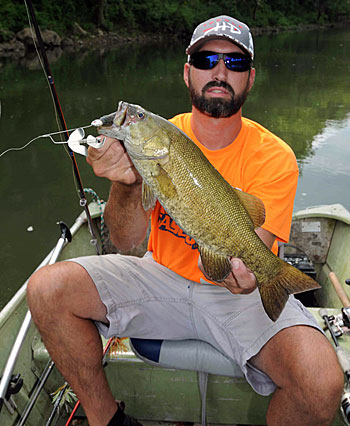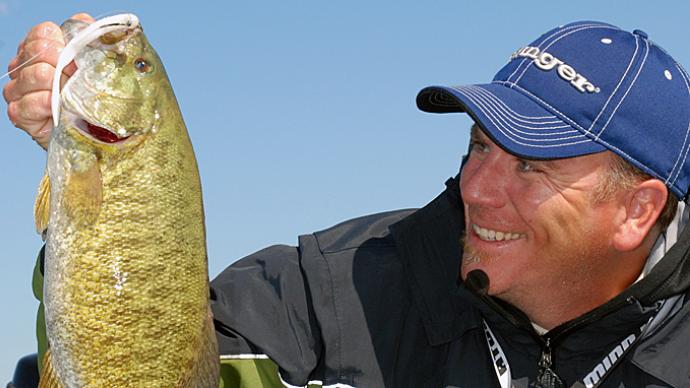
Plop. Plop. Plop. Plop. Plop. Plop. KaaWhoosh.
That was the sound of my Berkley Choppo 90 plopping across the river’s surface, followed by the explosion created by a smallmouth bass annihilating the topwater lure.
Gasconade River Guide, Tommy Bench, and I were afloat Bench’s home waters on a late summer weekday. The only sounds we heard all day were our buzzing and plopping topwater lures, the rippling water of the river, and an occasional lowing cow. The Gasconade River is one of the Missouri Ozarks streams loaded with smallmouth bass yet lacking fishing pressure. On our entire trip, the only other anglers we saw were at the spot where we put in Bench’s johnboat.
The heat of summer makes river fishing ideal for smallmouth. “The river in the summertime is magnificent because of the water temperature,” Bench says. “The warmer the water gets, the more active the fish are.”
Bench’s favorite time to fish for river smallmouth is in the fall. “Everything is good then,” he says. “The weather is usually good with mild temperatures and nice water, and the fish seem to feed well in the fall.”
Late summer/early fall is a time of transition for smallmouth when the nights get longer and cooler. The fish will feed longer in the shallows of the shoals in the morning and then move in and out of the deeper holes throughout the day. During this time of the year, rivers are usually low, so Bench targets smallmouth in areas near deep holes that have current flowing into logs and big rocks. “Smallmouth pretty much relate to cover and current,” Bench says.
The Missouri guide primarily relies on three lures to catch smallmouth during the late summer/early fall. His first choice is a jig to imitate crawfish, a smallmouth’s favorite forage. “It’s the best bait to throw year-round,” he says. Bench opts for 5/16 and 3/8-ounce jigs in green pumpkin or watermelon hues and tips the jig with 3-inch HD Tackle Hi-Def Craws in contrasting colors.
Bench’s next lure choice is a homemade 3/8- or 1/2-ounce TBench buzz bait with double silver blades and a chartreuse or white skirt. The buzzer is most productive in the lowlight conditions of early morning, late evening, and overcast days, but he has also caught quality smallies on the lure in bright sunshine. His third lure for late summer/early fall is a white Zoom Super Fluke impaled on a 3/0 or 4/0 Gamakatsu extra wide gap hook.

The Missouri angler slowly drags the jig along the bottom with 20-pound fluorocarbon line. “I want to feel every rock, crease, crevice, and log or anything on the bottom,” he says. “I want to know when I am coming over the cover. If I am on a rock, I can pop it off and get a reaction bite. Most of the time, I can drag it along the bottom, and the current does much of the work for me.”
After casting the jig upstream, Bench lets his jig fall on enough of a slack line to allow the flowing water to push the lure along with the current. Bench discloses that he throws all of his lures upstream most of the time for a more natural presentation. “I have always done better throwing up river and working my lure down,” he says. “The fish are looking up river for things to be pushed down to them.”
A steady retrieve of the buzz bait on 20-pound fluorocarbon line works best for Bench. “Sometimes I will throw it out over a log and let it sink almost like I would a spinnerbait,” he says. “I know it sounds kind of goofy to do that, but it works.”
Bench likes to skip the Fluke on 8-pound fluorocarbon around cover to get a reaction bite after the lure settles on the surface. If the skipping motion fails to trigger a strike, Bench lets the lure sink, tries a series of double twitches, and pauses to entice smallmouth into biting.
Another lure that produces for Bench on the river is a chartreuse Strike King KVD 1.5 Square Bill crankbait. Bench throws the crankbait on 10- or 12-pound fluorocarbon and tries to bang the lure into rocks and wood to trigger reaction strikes.
Bench can always catch numbers of bass from the shallower holes in the late summer/early fall, but he targets the deeper bluff holes for better quality smallmouth. “If you are just going out to target 3-, 4-, or 5-pound smallmouth, I would suggest going for deep water with cover, particularly logs that have been there for years,” he says. “That is a goldmine for big smallmouth.” He suggests the best spot to target is the head of a deep pool just below the riffles.
During our float trip, we were fortunate to fish under a mostly overcast sky, so we threw topwater lures most of the time. I caught about 15 smallmouth, mostly on the Choppo, and estimated that I missed another 10 to 15 bites on the topwater plug. Bench caught about the same number of keepers on his trusty buzz bait and missed several blowups.
BassResource may receive a portion of revenues if you make a purchase using a link above.




